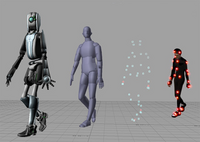
Photo from wikipedia
Computer graphics artists often resort to compositing to rework light effects in a synthetic image without requiring a new render. Shadows are primary subjects of artistic manipulation as they carry… Click to show full abstract
Computer graphics artists often resort to compositing to rework light effects in a synthetic image without requiring a new render. Shadows are primary subjects of artistic manipulation as they carry important stylistic information while our perception is tolerant with their editing. In this paper we formalize the notion of global shadow, generalizing direct shadow found in previous work to a global illumination context. We define an object's shadow layer as the difference between two altered renders of the scene. A shadow layer contains the radiance lost on the camera film because of a given object. We translate this definition in the theoretical framework of Monte‐Carlo integration, obtaining a concise expression of the shadow layer. Building on it, we propose a path tracing algorithm that renders both the original image and any number of shadow layers in a single pass: the user may choose to separate shadows on a per‐object and per‐light basis, enabling intuitive and decoupled edits.
Journal Title: Computer Graphics Forum
Year Published: 2019
Link to full text (if available)
Share on Social Media: Sign Up to like & get
recommendations!